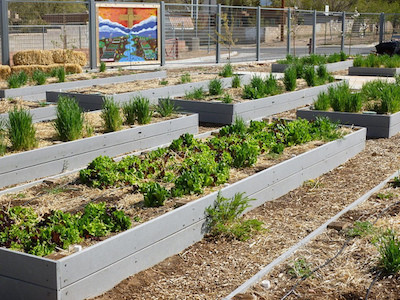School Gardens: Sowing and Reaping the Benefits
In the last decade, school gardens have become increasingly popular in public schools. While some parents have been known to complain, others have embraced the idea as a wonderful chance for students to learn about the food chain. The U.S. Department of Agriculture supports school gardens as part of the “Farm to School” movement which aims to establish healthy eating habits and encourages school districts to buy local food.
Why school gardens?
School gardens are not a new concept, and have been a part of the elementary school system for decades. They were once seen as a tool to provide rural school teachers with food. Many schools had “Victory Gardens” during both World Wars. School gardens helped reduce the overall costs of purchasing food during the Great Depression.
Today, school gardens are making a comeback for several reasons. In addition to the practical purpose of producing a small amount of food, school gardens can help children connect to nature in a real way. The garden is a teaching tool, and one that takes many hands to succeed.
- Gardens create a connection between students and the natural world
- They provide hands-on approach to learning and understanding the food chain
- Gardens help students understand the role of farmers and other agricultural producers in providing the world with food
- Students learn how to garden for fun and for food
These gardens are a great way to help children learn about how we plant, grow, reap and sell their agricultural products, and provides a tangible connection to the choices and limitations we face in making decisions about our food.
Benefits of school gardens
While school gardens are a positive way to show children where their food comes from, they also play a role in the overall education system. School gardens are an excellent and practical way to help children learn about nutrition, according to the American Heart Association. The Heart Association has been working to create Teaching Gardens to help children learn about healthy nutritional choices. This is all part of their campaign to fight childhood obesity.
For the American Heart Association, school gardens accomplish several basic goals:
- They teach children about the source of food
- They interest children in nutritional alternatives to overly processed food
- They provide children with exercise
- They help direct children towards making healthy food choices
The American Heart Association sees school gardens as a means of battling the problem of obesity among school children. By understanding more about and helping to grow food, children be better equipped to make healthy choices as they grow up. Recent research by Cornell University found that those who participated in school gardens were more physically active than students who did not.
There are other benefits that grow from the relationship between students and gardens. They can act as viable and valuable teaching tools that help students integrate other school subjects including math, science, art, health, physical education and social studies, according to the Tampa Bay School Garden Network. Additionally, gardens can instill a sense of school pride.
The use of school gardens as a teaching tool also appears to fits in with the current approach to many school theories where integration is the key, particularly with the science and math. Moreover, gardening is said to improve a child’s ability to accept social and personal responsibility. As Erasmus Schwab, a school garden advocate, noted in 1879: “School gardens are a fountain for the knowledge of nature and its consequent pleasure, and an excellent means of training.”
Looking toward the future
School gardens seem to be picking up speed, growing throughout the nation as people and school boards consider the benefits that can accrue form children planting, growing and sowing. The USDA has also encouraged the movement by working with schools to purchase locally grown and produced items through the farm to school movement. Combined with the school garden projects, this seems to be a trend that will bear substantial fruit (or vegetables) as the movement grows.
Photo credit: Billie Greenwood / Flickr




